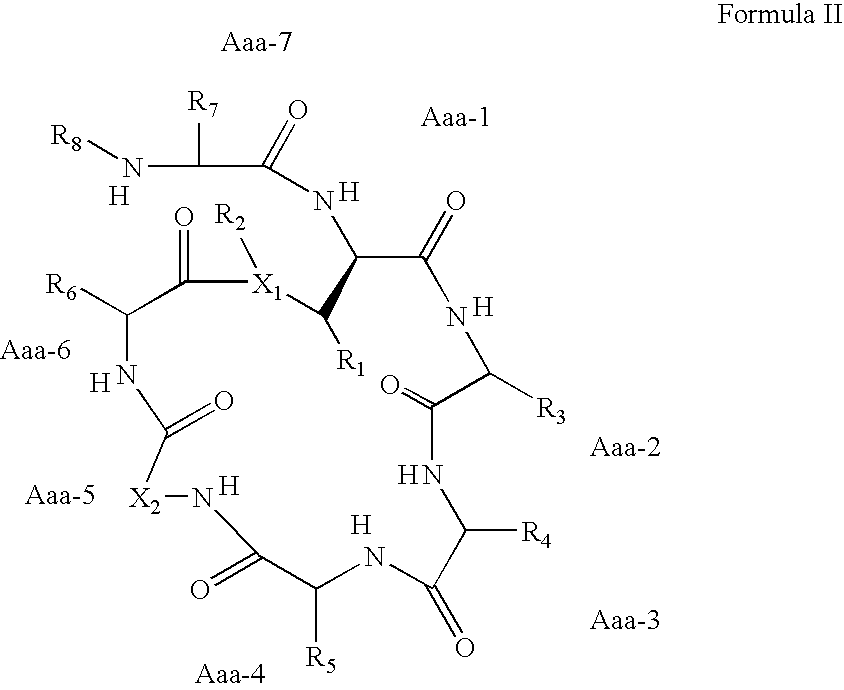Kahalalide compounds for use in cancer therapy
a technology of kahalide compounds and cancer, which is applied in the direction of biocide, plant growth regulators, pharmaceutical non-active ingredients, etc., can solve the problems of liver toxicity and dose limitation toxicity in the treatment of kahalide compounds, and achieve the effect of avoiding toxicity and improving clinical
- Summary
- Abstract
- Description
- Claims
- Application Information
AI Technical Summary
Benefits of technology
Problems solved by technology
Method used
Image
Examples
example 1
Preliminary Report
Phase I and Pharmacokinetic Study of Kahalalide F in Patients With Advanced Androgen Refractory Prostate Cancer
INTRODUCTION: Kahalalide F (KF) is one of a family of novel dehydroaminobutyric acid-containing peptides isolated from the Hawaiian herbivorous marine species of mollusk, Elysia rufescens. KF displays both in vitro and in vivo anti-tumour activity in various solid tumour models including breast, colon, non-small cell lung, and in particular prostate cancer. On the basis of its selectivity, KF is now further developed as a potential anticancer agent against androgen independent prostate tumours. OBJECTIVE: In the present phase I clinical and pharmacokinetic (PK) study the toxicity profiles PK and anti-tumour activity of KF are investigated. METHODS: KF is administered as an intravenous infusion over one hour, during five consecutive days every three weeks in patients with advanced or metastatic androgen refractory prostate cancer. On the basis of the M...
example 2
KHF-A-001-00. Phase I Clinical and Pharmacokinetic study to determine the safety of kahalalide F administered as a daily x 5 over 1 hour Infusion every 21 days in patients with advanced or metastatic prostate cancer.
The first clinical trial with KHF is being run in The Netherlands. It is addressed to prostate cancer patients according to the high selectivity exhibited in the preclinical programme. The toxicity data in rodents and dogs shows the feasibility to give daily doses equivalent to the single dose MTD in a repeated fashion (daily times five): such schedule may significantly enhance the therapeutic profile of KF in patients bearing hormone resistant prostate cancer.
A dose of 20 mcg / m2 was considered a safe starting dose on the basis of acute toxicity studies in animals. The trial was designed as an accelerated dose escalation (pharmacokinetically guided).
One patient (the first one treated in this trial) received 4 cycles at the first dose level. 2 months after stopping...
example 3
KHF-A-002-01. Phase I Clinical and Pharmacokinetic study to determine the safety of Kahalalide F administered as a weekly infusion over 1 hour in patients with solid tumours.
This trial was addressed to any solid tumours and was designed as a classical escalation. The starting dose was higher because we had some information from the first trial, and this allowed us to skip the first steps. One cycle in this trial means a week, so 4 cycles mean 1 month of treatment.
The second dose level (400) was expanded because of two unrelated adverse events: grade 3 diarrhea and death due to gastrointestinal bleeding. This was also the reason why the next escalation was only 32.5% instead of 50%. No toxicities were reported in this level and the following escalation was 50% again.
The DLT was identified at 1200 mcg / m2, and was grade 4 hypertransaminasemia non reversible by day 21. The time of onset was located at 5 hours after the infusion. This was not a scheduled determination and that was...
PUM
| Property | Measurement | Unit |
|---|---|---|
| Time | aaaaa | aaaaa |
| Time | aaaaa | aaaaa |
| Time | aaaaa | aaaaa |
Abstract
Description
Claims
Application Information
 Login to View More
Login to View More - R&D
- Intellectual Property
- Life Sciences
- Materials
- Tech Scout
- Unparalleled Data Quality
- Higher Quality Content
- 60% Fewer Hallucinations
Browse by: Latest US Patents, China's latest patents, Technical Efficacy Thesaurus, Application Domain, Technology Topic, Popular Technical Reports.
© 2025 PatSnap. All rights reserved.Legal|Privacy policy|Modern Slavery Act Transparency Statement|Sitemap|About US| Contact US: help@patsnap.com



